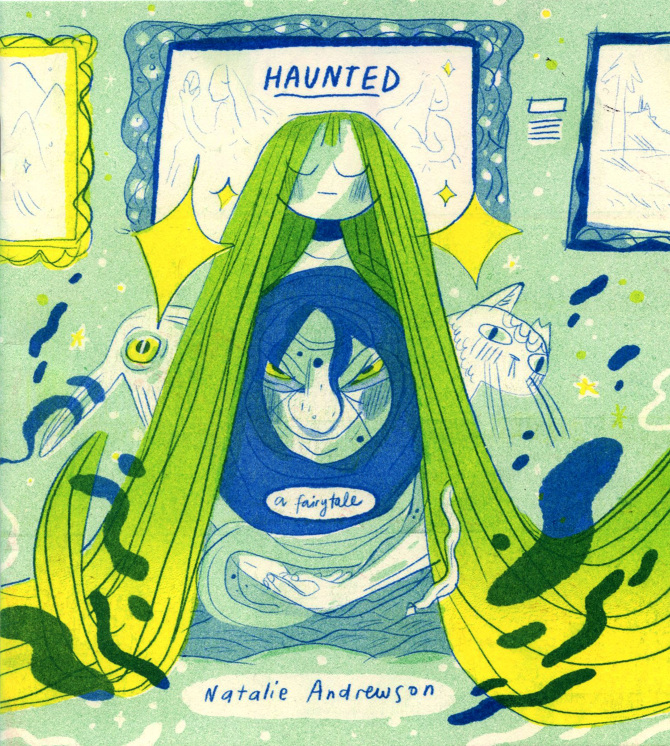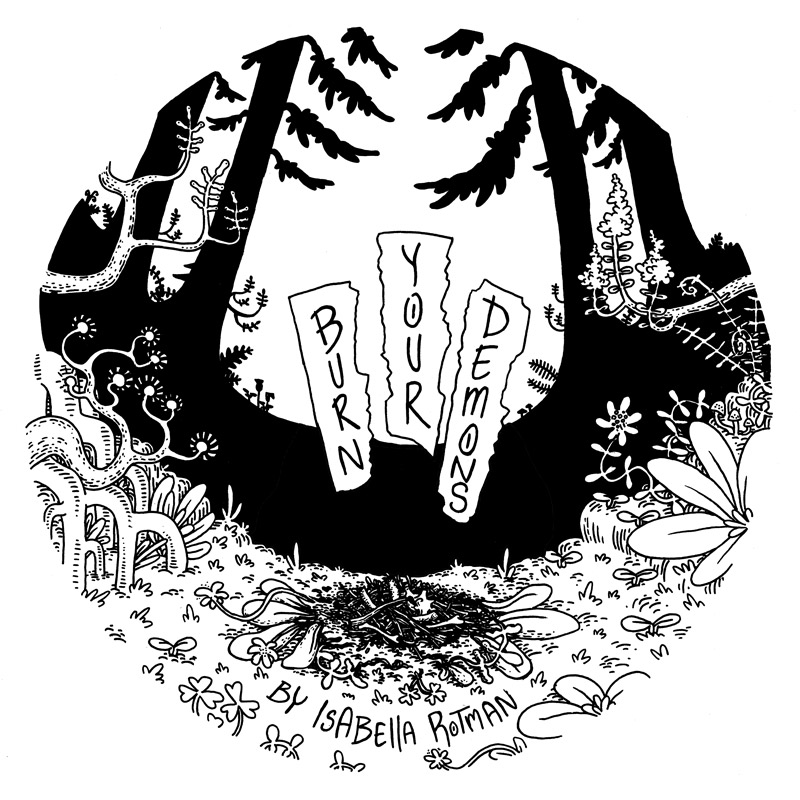Cartoon Crossroads Columbus (or CXC) is a four day festival in Columbus, Ohio celebrating the work of cartoonists and providing chances to learn more about the medium. It’s mission is “to provide an international showcase for the best of cartoon art in all its forms, including comics, animation, editorial cartoons, newspaper strips, and beyond, in a city that is a growing center of importance to comics and cartooning. We also focus on helping the next generation of young cartooning talent develop thriving careers that invigorate the industry for years to come.” In the spirit of this mission, the Comics Beat has conducted a series of interviews with some of the phenomenal cartoonists in attendance at this year’s Cartoon Crossroads Columbus. We hope that these interviews will improve our understanding of these creators voices, techniques, interests and influences as well as provide a platform for comics enthusiasts to discover new artists and challenge their conceptions of comics.
This year, Cartoon Crossroads Columbus is collaborating with SÕL-CON, The Brown and Black Comics Expo. SÕL-CON focuses on creators with a Latino or African-American background. It’s a different entity and convention than CXC, but they are collaborating this year to make a more wholesome experience for attendees. Some creators are attending this joint collaborative event and this includes Andrés Vera Martinez. Andrés is a cartoonist and illustrator based in Cape Elizabeth, Maine. He’s the co-author of Little White Duck: A Childhood in China, a graphic novel about the impact of China’s cultural revolution on two young girls. He’s currently working on his longest project to date called Courage to Dream, with Neal Shusterman for Scholastic. We’ve talked about colour in his work, parenting and his latest project, Courage to Dream.
—
Philippe Leblanc: For those readers who may not be familiar with you and your work, can you tell us a little bit about yourself?
Andrés Vera Martinez: Yes, I’m a cartoonist/illustrator originally from Austin, Texas. I know live and work in Cape Elizabeth, Maine. I’m married with two kids, two cats and a dog. I had worked in editorial, TV, and advertising Illustration for a few years in New York City until I initiated my own project, the middle grade graphic novel, Little White Duck: A Childhood in China. I found inspiration from my wife’s childhood stories and co-authored the book with her. It was well received and that helped me find focus in the types of stories I wanted to tell. I also had been focusing my energy on mentoring and teaching the last few years. Now, I’m working on a new book for Scholastic, called Courage to Dream, written by Neil Shusterman.

PL: Your colour comics have this amazing depth to them that I find remarkable. How do you approach colours in your work?
AVM: I studied painting long ago at the School of the Art Institute of Chicago for my undergraduate degree. I suppose the skills I learned from studying color and trying to interpret it with paint helped when I began using digital programs to color my comics. I learned later the importance of using color to enhance the storytelling in comic pages which is just as interesting to me as painting.
PL: In addition to being an accomplished artist, you are also a father. Parenting is a full-time job with children at home. How have you managed to adapt to the time constraint this causes on your ability to create? And do you think becoming a parent changed your perspective on the art you’re making?
AVM: My wife and I decided to have a baby in my last year of the SVA MFA Illustration program. We knew we wanted to care for a little human and we were not getting any younger so we went for it. We had a beautiful girl. After graduating I had to take various illustration jobs mainly to help pay the rent. I did work in editorial, TV, and advertising Illustration for a few years. It was a real financial challenge to keep the freelance work going, but we did it. Although I was becoming a seasoned professional illustrator I still wanted to break into comics. I thought super-hero comics were the way to go and I got an opportunity directly from Axel Alonso at Marvel to try out for the Punisher comic series. It was for their adult line so the script had tons of graphic violence. At the time, Marvel had distinct house styles for their books and were not open to anything that looked “indie” but Axel was doing his best to give me a shot, even considering having my mentor Klaus Janson ink my work. It was exciting but I backed out for an unexpected reason. As a new father, I was being turned off by the violence in the script. On top of that I was doing an advertising job for the Dexter TV show. It also had me drawing lots of blood and guts. My daughter could peek over my drawing table at this point and it just felt wrong. Maybe this is what pushed me to initiate my own project, Little White Duck! I know there are plenty of dad illustrators out there that love to work in horror and action stories but I just realized it wasn’t for me and having kids made me realize this. Know that I have two kids it’s a juggling act on time to work. With my first child, I was younger and I didn’t need much sleep. I was also hungry for success and money so I plowed through the work and tried to be super-dad. Now being older and more financially stable I just take things easier. However, I think I’m due for a little renaissance. My boy is three and in pre-school so I’m looking forward to being more productive, hopefully being able to produce two books a year.

PL: You’ve been working on Courage to Dream, a 250-page graphic novel written by Neal Schusterman to be published by Scholastic. Could you give us some details on the genesis of the graphic novel, how you got involved and what it is about?
AVM: We had just had our second child and moved out of New York City. My wife started working as a physician in Maine and I was hired as an Associate Professor of Illustration at a college in Massachusetts when I got a call that Scholastic received the script they had been waiting for. Three years had gone by when I first heard about the script and the editor was still set on hiring me for the job. He said he and the writer didn’t want anyone else to illustrate the story and hoped that I was still interested in taking it on. I read the script and despite not having the time to do it, I said yes. It’s a wonderful script and the type of story that I like to bring to life in pictures. Set in World War II, the book is made up of several short stories about the Jewish experience during the war. Unlike Schindler’s List or Maus, where the story is directed at adults, this is Scholastic, so the protagonists are all aged between five and fifteen years old, and that is what makes it so unique. The reader sees this difficult time through the eyes of children and it opens the opportunity to delve into how they cope through a colorful world of fantasy. The dark reality and the colorful characters drawn from Jewish myths clash and make the stories engaging. It’s my favorite type of story where history and fantasy mix. Some of my favorite stories are One Hundred Years of Solitude, Frankenstein, Pan’s Labyrinth and Bless Me Ultima, where the lines of reality and fantasy are blurred through magic realism. Being of latinx heritage I grew up with magic realism as a natural state. My grandfather would tell us “true stories” of the demon that hunted him and his starving orphaned brothers and sisters during the Great Depression. He said the demon kept him on his toes and helped them survive. I found connections to the characters in Courage to Dream. It has been challenging to draw, knowing the kids in the stories are based on terrible historical facts, but inspiring to illustrate because of the hope and positive tone the stories portray. The book has strong protagonist fighting against all odds, siding with magical creatures and beings trying to overcome tragedy. It’s a wonderful script. I’m looking forward to finishing it.
PL: Courage to Dream will be your longest project to date. How do you approach such an ambitious project?
AVM: Well, I had a discussion with my wife and she advised me to quit my teaching job. It was a tough decision because I enjoy teaching but it would have been too much, commuting to teach three days a week, helping raise the kids and then taking on a huge graphic novel project. We are now in a better place financially and my kids are still young so I decided to focus on them and this new project. I’ve thumb nailed most of the book and I’m picking up the pace since my boy started pre-school. We are aiming for a Fall of 2018 release!

PL: What do you want readers to take with them once they’ve finished reading your comics?
AVM: I hope I can provide young readers with entertaining stories that they don’t get to hear about often enough in popular culture. Both sides of my family are of mixed Spanish and Native American heritage, we are bilingual. We have been in Texas for over two hundred years, working as cowboys, in farm fields, oil fields, in the tech industry and fighting in wars to defend our country. We have endured, keeping our language and culture, despite challenges from our government and many white people in power treating us unjustly through generations. My wife is an immigrant from China. She came here to better herself and contribute to our society positively. She is a doctor of hematology and oncology and saves lives every day. It is natural for me to have people of color as protagonist in my comics. It’s what I know. I think it’s important for me to step up as a leader in representing people of color in comics, because out of the thousands of professionals in the field there are only a handful of us. I surely don’t think it’s the lack of talent but the opportunities. If there are only a handful of us in the field then there are even less in the positions of hiring such as publishers, editors and art directors. Striving for equal opportunity is something I believe in strongly and although I want to tell stories to entertain, I hope that this comes through as well. I mentor students of color because I believe in their talents. People of color have varied and unique American stories that are not always about race and if given the chance to share our perspective, experience and talent on a bigger stage then I believe it can grow the collective consciousness of our country to be more inclusive, diverse, and just more interesting, because as you have seen recently in the news there is still lots of room to grow.
—
You can follow Andrés Vera Martinez’s work on his website, or follow him on Twitter, Instagram or Tumblr. You can also buy his work on his online store.
Andrés will be at Cartoon Crossroads Columbus and Sol-Con this weekend and also participating on a panel: Creators of Color & Industry. He’s looking forward to meeting you!









